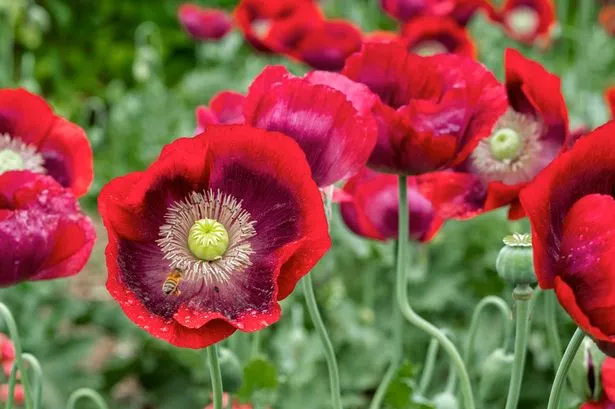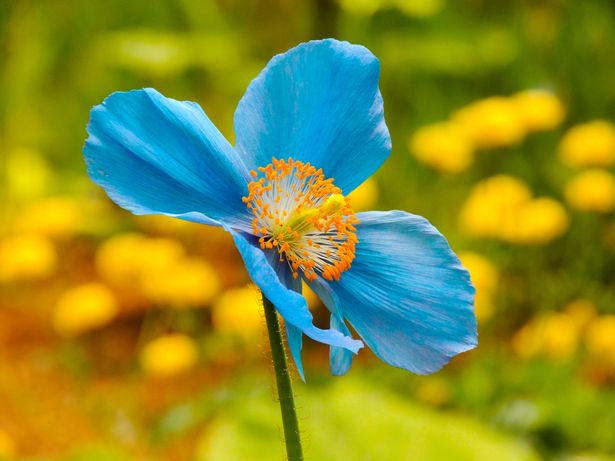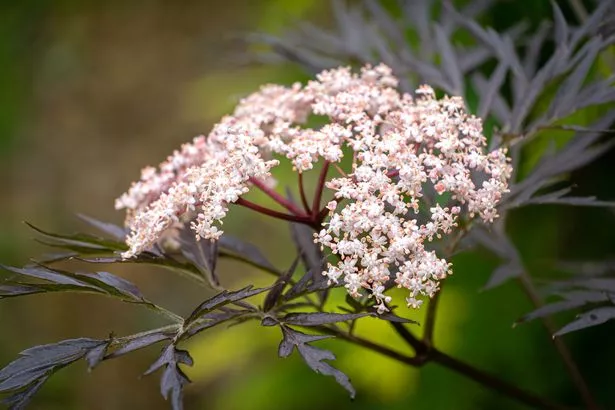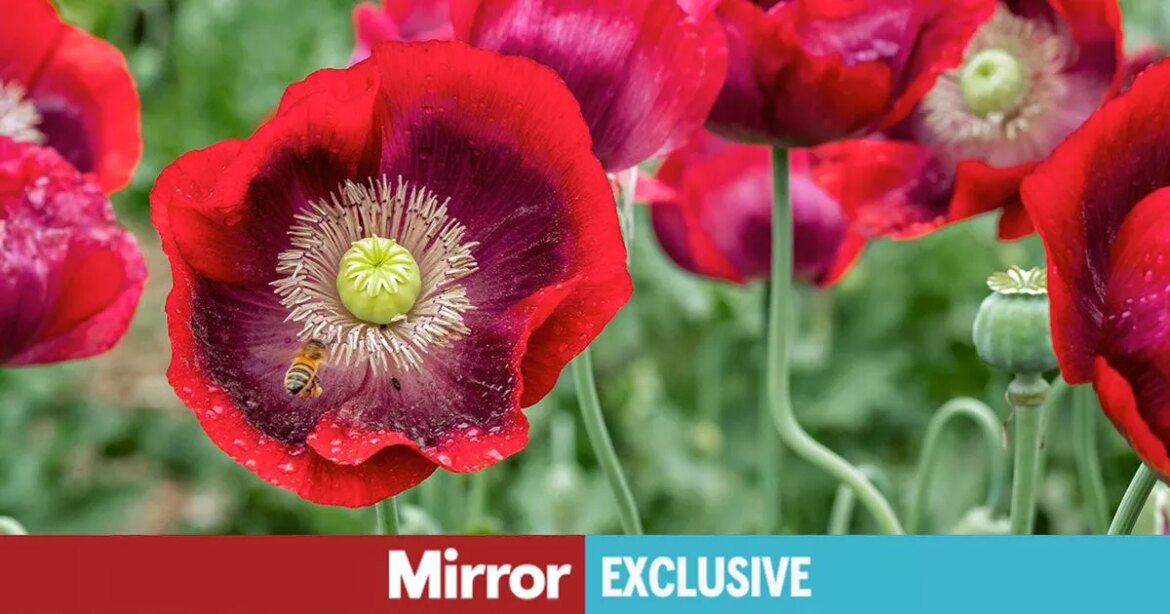Sow your opium poppies – used to make medical painkillers including morphine, codeine and oxycodone, as well as illegal narcotic heroin – in autumn or spring for a bumper crop in summer A bit of planning will ensure a full display of vibrant red poppies in your summer garden(Image: Getty Images/500px Plus)
A bit of planning will ensure a full display of vibrant red poppies in your summer garden(Image: Getty Images/500px Plus)
Oriental poppies have begun to bloom in the front garden, bringing with them a riot of colour and drama. Their flamboyant, bright orange-red petals are striking, each flower marked with a dark, almost black blotch at the base, encircling a regal-looking purple centre.
Though their display is brief, typically lasting around ten days, their perennial nature makes them a reliable and rewarding addition to a mixed border, returning year after year. These poppies grow on stout, hairy stems that can sometimes flop under the weight of their impressive blooms.
A little forward planning can help here — staking the stems early in the season provides much-needed support to keep the flowers upright and looking their best. There’s also a wide array of stunning cultivars to explore. ‘Royal Wedding’, for instance, produces silky white petals with a dramatic purple blotch at the base, while the beloved ‘Patty’s Plum’ is admired for its maroon, ruffled flowers.
After flowering, oriental poppies can be cut back to tidy up the plant, though many gardeners choose to leave the ornamental seedheads in place for their sculptural beauty. While these cultivars don’t grow true from seed, they can be propagated through root cuttings — a task best tackled in autumn. Simply dig up the plant, snip healthy roots into 4cm lengths, and plant them in cuttings compost. The parent plant can then be returned to the soil to re-establish itself.
 The corn poppy, Papaver rhoeas, is also known as the field or Flanders poppy and has become a powerful symbol of remembrance for those lost in war(Image: Getty Images/500px)READ MORE: Warning as popular plant banned from sale with gardeners urged to ‘bin it’
The corn poppy, Papaver rhoeas, is also known as the field or Flanders poppy and has become a powerful symbol of remembrance for those lost in war(Image: Getty Images/500px)READ MORE: Warning as popular plant banned from sale with gardeners urged to ‘bin it’
Among annual poppies, the corn poppy, Papaver rhoeas, is perhaps the most iconic. Also known as the field or Flanders poppy, it has become a powerful symbol of remembrance for those lost in war. Its seeds are remarkably resilient, capable of lying dormant for decades until disturbed.
During the First World War, the upheaval of soil on battlefields in France and Belgium caused these poppies to bloom en masse, creating vivid displays that inspired Lieutenant Colonel John McCrae’s famous poem: In Flanders fields the poppies blow, between the crosses, row on row…
Another notable species is Papaver somniferum, the opium poppy. Historically associated with the Opium Wars between Britain and China in the 19th century, this species is still cultivated today for medicinal purposes as the natural source of morphine and codeine. In the garden, however, it’s prized more for its striking ornamental forms.
These hardy annuals are best sown directly into the ground in spring or autumn, as they dislike being transplanted. Varieties such as ‘Black Swan’, with its finely cut, deeply coloured petals, or the heirloom ‘Hungarian Blue’, known for its simple, silky purple blooms, make bold, beautiful statements.
 Native to the mountainous regions of Nepal, Tibet, and Myanmar, the Himalayan blue poppy is seen as the ‘holy grail’ of blue flowers(Image: Getty Images)
Native to the mountainous regions of Nepal, Tibet, and Myanmar, the Himalayan blue poppy is seen as the ‘holy grail’ of blue flowers(Image: Getty Images)
For gardeners with acidic soil and cooler, damp climates, the elusive Himalayan blue poppy, Meconopsis betonicifolia, might be worth a try. Native to the mountainous regions of Nepal, Tibet, and Myanmar, this rare, short-lived perennial is often considered the “holy grail” of blue flowers.
Though notoriously tricky to grow, it thrives in the cooler, wetter conditions of northern England and Scotland. However, even a brief spell of strong sun in dry weather can quickly damage these delicate, captivating blooms. With their dazzling beauty, fascinating histories, and evocative symbolism, poppies continue to enchant gardeners, poets, and nature lovers alike.
Jobs to do in the garden this weekPlant out young courgettes, pumpkins, and squashes. If you didn’t grow these from seed, there are plenty available in garden centres.Thin out carrot seedlings – remove these thinned seedlings because if they are left about their scent will attract carrot fly. You can cover with horticultural mesh to keep this away.Collect seed from candelabra primulas and sow fresh. Pop a few nasturtium seeds in pots for a late summer vibrant display. Thin out carrot seedlings and cover with horticultural mesh to keep carrot fly away(Image: Getty Images)Start feeding tomatoes in grow bags with high potash feed to encourage flowers and fruit formation.Tie in climbing and rambling roses – the more you train them horizontally, the more this will encourage side shoots to develop and go on to produce more flowers.Water containers, pots, window boxes and feed them fortnightly.Train sweet peas and start cutting flowers as they appear so you’ll get more.Plan for next spring – now’s the time to start sowing seeds of Bellis perennis, polyanthus, pansies and wallflowers so they will be in flower (when very little else is) for brightening up the garden in late winter/early spring.Soft fruit such as gooseberries need netting over them before the birds tuck in.Plant of the week: Sambucus ‘Black Lace’
Thin out carrot seedlings and cover with horticultural mesh to keep carrot fly away(Image: Getty Images)Start feeding tomatoes in grow bags with high potash feed to encourage flowers and fruit formation.Tie in climbing and rambling roses – the more you train them horizontally, the more this will encourage side shoots to develop and go on to produce more flowers.Water containers, pots, window boxes and feed them fortnightly.Train sweet peas and start cutting flowers as they appear so you’ll get more.Plan for next spring – now’s the time to start sowing seeds of Bellis perennis, polyanthus, pansies and wallflowers so they will be in flower (when very little else is) for brightening up the garden in late winter/early spring.Soft fruit such as gooseberries need netting over them before the birds tuck in.Plant of the week: Sambucus ‘Black Lace’ Elderflowers are producing their distinctive flat heads of scented flowers, and foragers will be gathering these to produce the distinctive cordial(Image: Getty Images)
Elderflowers are producing their distinctive flat heads of scented flowers, and foragers will be gathering these to produce the distinctive cordial(Image: Getty Images)
Elderflowers are producing their distinctive flat heads of scented flowers, and foragers will be gathering these to produce the distinctive cordial. ‘Black Lace’ is a cultivar with finely cut dark purple leaves and pink flowers. It comes as a large deciduous shrub or small tree, and is good as an ornamental plant for smaller gardens. Grown in full sun or partial shade in well-drained soil, the flowers and fruit are valuable to wildlife.
Tiso’s camping range
This article contains affiliate links, we will receive a commission on any sales we generate from it. Learn more
£230
£84
Tiso
Buy Now on Tiso
This tent has a waterproof polyester flysheet to withstand heavy rain, lantern hanging points and internal storage pockets.

